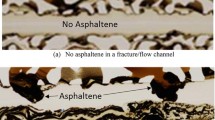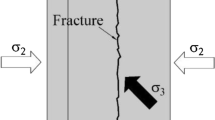Abstract
Fractured reservoirs are important hydrocarbon resources. However, the production of hydrocarbon makes fractures to be sealed which in turn decreases the production rate. A better understanding of permeability, porosity, and compressibility of fractures would be useful in optimizing the production rate. This research paper explored stress-dependent permeability, porosity, and compressibility of fractured porous media, both experimentally and numerically. The laboratory results are used to calibrate numerical models. With this regard, the roles of fracturing parameters such as orientation, opening, fracture density, persistency, and the intersection of fractures on hydro-mechanical parameters of the fractured sample are analyzed individually. The results indicate that stress sensitivity of permeability and compressibility is more in fractured porous media than in non-fractured ones. The results gained also showed that samples with open fractures and no filling materials, dominant vertical fractures, and high fracture density have the most stress dependency of permeability and compressibility, while in high fracture densities, the fracture and matrix changes are close to each other. The intersection of joints and not persisted fractures act as obstacles. This causes the fluid to be trapped in porous media that affect reservoir recovery and increase financial losses. Finally, an analytical relationship is developed to calculate the matrix compressibility














Similar content being viewed by others
Change history
14 April 2021
Figure 5 continued incorrectly captured during publication, this is now correctly updated here.
References
Abass HH, Ortiz I, Khan MR, Beresky JK, Armaco S, Sierra L, Halliburton (2007) “Understanding stress dependent permeability of matrix, natural fractures, and hydraulic fractures in carbonate formations”, Society of Petroleum Engineers. SPE 110973(May):1–8
Aguilera R (1999) Recovery factors and reserves in naturally fractured reservoirs. J Can Pet Technol 38(7):15–18
Aloki Bakhtiari H, Moosavi A, Kazemzadeh E, Goshtasbi K, Esfahani MR, Vali J (2011) The effect of rock types on pore volume compressibility of limestone and dolomite samples. Geopersia 1(1):37–82
Bagherzadeh P, Goshtasbi K, Kazemzadeh E (2021) Stress-dependence of the permeability, porosity, and compressibility of fractured carbonate rock. J Porous Media 24(5):21–45
Carvajal J, Saavedra N, Calderon Z (2010) Stress effect on compressibility of weakly anisotropic micro-fractured rocks a study case on Colombian foothills tight sandstones. 44th U.S. Rock Mechanics Symposium and 5th U.S.-Canada Rock Mechanics Symposium, June 27–30
Chacon, A. (2006) Effect of pressure depletion on hydrocarbon recovery in naturally fractured reservoirs", a dissertation submitted in partial fulfillment of the requirements for the degree of doctor of philosophy, Norman, Oklahama
Chen D, Pan Z, Ye Z (2015) Dependence of gas shale fracture permeability on effective stress and reservoir pressure: model match and insights. Fuel 139:383–392
Chen D, Pan Z, Ye Z, Hou B, Wang D, Yuan L (2016) A unified permeability and effective stress relationship for porous and fractured reservoir rocks. J Nat Gas Sci Eng 29:401–412
Detournay E, Cheng A (1993) Fundamental of poroelasticity. In: Fairhurst C (ed) Comprehensive Rock Engineering: Principles, Practice and Projects, Vol. II, Analysis and Design Method. Pergamon Press, pp 113–171
Dong JJ, Hsu JY, Wu WJ, Shimamoto T, Hung JH, Yeh EC, Sone H (2010) Stress-dependence of the permeability and porosity of sandstone and shale from TCDP Hole-A. Int J Rock Mech Min Sci 47(7):1141–1157
Dwi HF, Natalia S, Castillo D (2007) The effect of pressure depletion on geomechanical stress and fracture behavoir in gunung kembang field. In: In procceding of indonesion petroleum Association. Annual Convention and Exhibition, Thirty-first
Ghanizadeh A, Gasparik M, Amann-Hildenbrand A, Genesterblum Y, Krooss BM (2014) Experimental study of fluid transport processes in the matrix system of the European organic-rich shales: I. Scandinavian Alum Shale. Mar Pet Geol 51
Haifeng Z, Jun S, Erfei M, Hang C, Guohua L (2015) Scale model of stress sensitivity for fractured low permeability reservoirs. Proceedings, Fortieth Workshop on Geothermal Reservoir Engineering Stanford University, Stanford, California, SGP-TR-204
Hall HN (1953) Compressibility of reservoir rocks. Pet Trans AIME 198:309–311
Harari Z, Shu-Teh W, Salih S (1995) Pore-compressibility study of Arabian carbonate reservoir rocks. SPE Form Eval 10(4):207–214
Itasca CG (2013) 3DEC-User manual. Itasca ConsultingGroup, Minneapolis
Jalalh AA (2006a) Compressibility of porous rocks: Part I. Measurements of Hungarian Reservoir Rock Samples. Acta Geophys 54(3):319–332
Jalalh AA (2006b) Compressibility of porous rocks: Part II. New relationships. Acta Geophys 54(4):399–412
Liu HH, Rutqvist J, Berryman JG (2009) On the relationship between stress and elastic strain for porous and fractured rock. Int J Rock Mech Min Sci 46(2):289–296
Lun ZL, Yefei C, Zhengfu N, Xuelin W, Lifang L, Xi C (2013) Stress sensitive experiments for abnormal overpressure carbonate reservoirs: a case from the Kenkiyak fractured-porous oil field in the littoral Caspian Basin. Pet Explor Dev 40(2):208–215
Luo J, Stevens R (1996) Micromechanics of randomly oriented ellipsoidal inclusion composites Part II: elastic moduli. J Appl Phys 79(12):9057–9063
MA Y, Pan Z, Zhong N, Connell LD, Down DI, Lin W, Zhang Y (2016) Experimental study of anisotropic gas permeability and its relationship with fracture structure of Longmaxi Shales, Sichuan Basin, China. Fuel 180:106–115
Moosavi SA, Goshtasbi K, Kazemzadeh E, Bakhtiari HA, Esfahani MR, Vali J (2014) Relationship between porosity and permeability with stress using pore volume compressibility characteristic of reservoir rocks. Arab J Geosci 7(1):231–239
Newman GH (1973) Pore-volume compressibility of consolidated, friable, and unconsolidated reservoir rocks under hydrostatic loading. J Pet Technol 25(2):129–134
Pan Z, Ma Y, Connell LD, Down DI, Camilleri M (2015) Measuring anisotropic permeability using a cubic shale sample in a triaxial cell. J Nat Gas Sci Eng 26:336–344
Pinzon CL, Chen H, Teufel LW (2000) Complexity of well testing analysis of naturally-fractured gas-condensate wells in Colombia. Paper SPE 59013 presented at the 2000 SPE international petroleum conference and exhibition, Mexico
Ross DJK, Bustin RM (2008) Characterizing the shale gas resource potential of Devonian-Mississippian strata in the Western Canada sedimentary basin: Application of an integrated formation evaluation. AAPG Bull 92(1):87–125
Soeder DJ (1988) Porosity and permeability of Eastern Devonian gas shale. SPE Form Eval, (March), pp 16–24
Tan Y, Pan Z, Feng XT, Zhang D, Connell LD, Li S (2019) Laboratory characterization of fracture compressibility for coal and shale gas reservoir rocks: a review. Int J Coal Geol 204:1–17
Tan Y, Pan Z, Liu J, WU, Y., Haque, A., & Connell, L. D. (2017) Experimental study of permeability and its anisotropy for shale fracture supported with proppant. J Nat Gas Sci Eng 44:250–264
Tao Q, Ehlig-economides CA, Ghassemi A (2009) Investigation of stress-dependent fracture permeability in naturally fractured reservoirs using fully coupled poroelastic displacement discontinuity model.” In SPE annual conference and exhibition. USA
Wang Z, Jin X, Wang X, Sun L, Wang M (2016) Pore-scale geometry effects on gas permeability in shale. J Nat Gas Sci Eng 34:948–957
Zhang G, Ranjith PG, Liang W, Haque A, Perera MSA, Li D (2019) Stress-dependent fracture porosity and permeability of fractured coal: an in-situ X-ray tomography study. Int J Coal Geol 213:103279
Zheng Z (1993) Compressibility of porous rocks under different stress conditions. Int J Rock Mech Min Sci Geomech Abstr 30(2):1181–1184
Zheng J, Ju Y, Liu H, Zheng L, Wang M (2016) Numerical prediction of the decline of the shale gas production rate with considering the geomechanical effects based on the two-part Hooke’s model. Fuel 185:362–369
Zhou J, Zhang L, Li X, Pan Z (2019) Experimental and modeling study of the stress-dependent permeability of a single fracture in shale under high effective stress. Fuel 257:116078
Zimmerman W, Somerton WH, King MS (1986) Compressibility of porous rock. J Geophys 91(6):765–777
Notations
The following symbols are used in this paper:
uhjoint normal displacement
uh0joint aperture in zero normal stress
∆unnormal displacement of fracture
Ctffracture compressibility
ϕffracture porosity
Kffracture permeability
ϕfiinitial fracture porosity
Kfiinitial fracture permeability
Ppiinitial pore pressure
Ppcurrent pore pressure
bcurrent fracture width
biinitial fracture width
ΔVfvariation of fluid volume
Kffluid bulk modulus
ζvariation of fluid content
Papplied confining pressure
ppore pressure
BSkempton pore pressure coefficient
Cpc (f)fracture compressibility
Cpc(m)matrix compressibility
αBiot coefficient
Kpbulk modulus for the pore volumetric strain
Kpermeability
Author information
Authors and Affiliations
Corresponding author
Rights and permissions
About this article
Cite this article
Bagherzadeh, P., Goshtasbi, K., Kazemzadeh, E. et al. Stress-dependence of the permeability, porosity, and compressibility in fractured porous media regarding fracturing condition. Bull Eng Geol Environ 80, 5091–5110 (2021). https://doi.org/10.1007/s10064-021-02215-4
Received:
Accepted:
Published:
Issue Date:
DOI: https://doi.org/10.1007/s10064-021-02215-4




